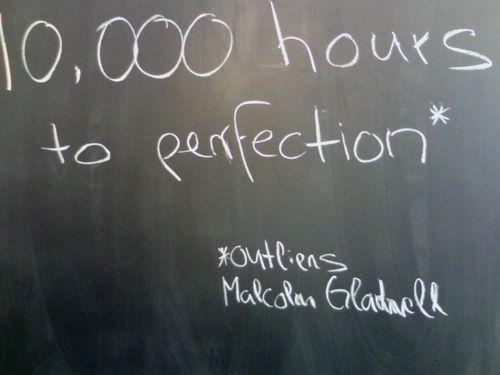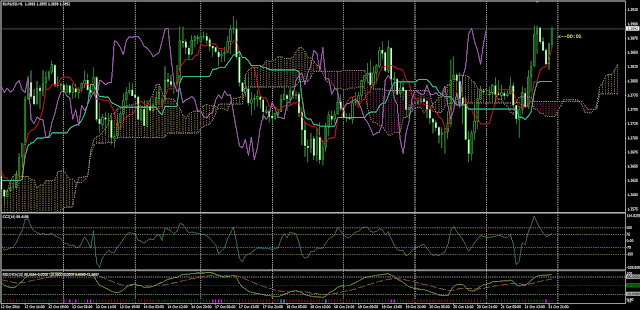HBR: A Fast Track to 10,000 Hours of Practice
Have you completed your 10,000 hours of deliberate practice?
The idea that 10,000 hours (about 1 year and 51 days total) of
practice is what you need to gain expertise in performance-based fields
was initially popularized in Malcolm Gladwell's bestseller Outliers. The research results he focused on emphasized the benefits of practice for fine-motor activities like playing the piano. But more recent studies
show the upside of the 10,000-hour benchmark for collaborative
knowledge work — the type of expertise required to create, or lead, or
grow a company.
For most of us, of course, logging that much deliberate practice may seem unattainable in today's time-scarce business environments. Employees barely have enough time to complete job responsibilities, no less find extra hours to practice their skills. (Even if your company generously put aside two-and-a-half work weeks per year for you to practice skills, it would still take you 100 years before you hit the 10,000 hour benchmark).
For most of us, of course, logging that much deliberate practice may seem unattainable in today's time-scarce business environments. Employees barely have enough time to complete job responsibilities, no less find extra hours to practice their skills. (Even if your company generously put aside two-and-a-half work weeks per year for you to practice skills, it would still take you 100 years before you hit the 10,000 hour benchmark).
But what if deliberate practice was your job, and the way your
organization did business? Then you and colleagues could feasibly hit
this threshold for mastery in as little as 5 years.
Here are three tips, grounded in our recent Babson Executive Education study of over 500 companies, to accelerate this process:
Here are three tips, grounded in our recent Babson Executive Education study of over 500 companies, to accelerate this process:
Try experimentation. Previous studies
show that experimentation is one of the most fundamental forms of
deliberate practice we can engage in. By performing more of their work
in the form of experiments, employees can synchronously advance projects
while putting hours in toward their 10,000. This synchronicity can
result in stronger organizational performance, according to our data.
Experimentation-oriented organizations, one-quarter of our survey
sample, are more than 4 times as likely to have achieved greater than
20% growth over the past year compared to others in the sample.
How is an experimental approach different than business as usual?
Much of conventional organizational work is about planning and analyzing
how to act, often on a large scale; risk is controlled by repeatable
processes and standard routines. Rather than planning to do things,
experimenting means doing things in a new way on a small scale. You get
quick feedback, allowing you to make timely adjustments and
improvements. On seeing the results of your action, practitioners can adopt the new way, discard it, or modify it and try again.
Maximize your opportunities to experiment. By understanding a variety of ways to experiment, employees can create more opportunities to accrue their 10,000 hours. Donald Schon's
seminal work on reflective practice identifies three basic
experimentation strategies, each of which we found at play in our own
research:
- Move testing is when you take action to produce an intended change. For instance, a technology vendor in our sample wanted to create a new, lower-cost offering to target customers who couldn't afford its custom software. Employees experimented by removing pricey features and consulting services from one of its products and purchase the software off-the-shelf. The move allowed the company to study intended benefits, as well as unanticipated changes. For example, the company discovered it would need to transition key R&D personnel onto the new product team to develop and sustain the offering.
- The same firm also engages in exploratory experimentation for initiatives with high levels of uncertainty, such as "trying out new concepts in [totally] new markets." This approach is about taking action only to see what happens. While exploratory experimenters intentionally avoid making predictions, often because they don't have reliable data, their actions generate data that can enable informed decisions and adjustments.
- Hypothesis testing is a way of trying out and comparing competing hypotheses. One firm we studied told us that "despite all indications, a competitor launched a product two years ahead of expectations, resulting in potentially significant losses for us in the US." Various division heads offered their take on how the company might respond. Rather than use her intuition to place a big bet on one response, the CEO asked each executive to test their hypothesis inside their division. After carefully monitoring experimental results, she then selected the most promising approach as a corporate response. "We successfully reduced the top line losses of millions of dollars," the CEO observed. As a result of "this success story," employees report that hypothesis testing is "now a key approach to reacting to any alarming change or threat in the marketplace."
Focus on the social side of experimentation. Our
research shows that experimentation in organizations is social and
highly collaborative. By networking with like-minded experimenters and
teaching to uninitiated colleagues, you create additional opportunities
to accelerate your way toward 10,000 hours.
Begin by asking a few tough questions. Where are the project delays?
Is there a big idea in the innovation pipeline that never seems to go
anywhere? These are situations that are ripe for experimentation. One
senior manager at an agriculture products firm described how an
"inexperienced team's analysis paralysis" was preventing them from
developing a marketing strategy for entering a lucrative geographic
area. In response, the manager is helping the team to devise experiments
to test competing hypotheses.
Not only is he helping to break the impasse, but he is starting others on their own journey toward 10,000 hours.
 |
| ค้นรูปมาใส่บล๊อกเพิ่มเติม เจอรูปนี้ ฮาดี^^ |
--------------------------------------------------------------------------------------------------------------------
ข้างล่างนี้คนละบทความกัน แต่ค้นเจอพอดี ขอรวมให้เป็นโพสต์เดียวเลยแล้วกัน
The Curse of the 10,000-hour ‘Talent Syndrome’
Imagine if someone told you that you needed 10,000 hours to learn to drive a car.
No? What about 5000 hours then? Would that be suitable?
How about 3000 hours? Or 1000? Or 500? Ok, how about 60 hours?
How about 3000 hours? Or 1000? Or 500? Ok, how about 60 hours?
A very average person with a reasonable fear of cars can learn to drive in about 60 hours.
Or can they? Because it depends on the car, doesn’t it? Is it a small
car? Is it a truck? Are you learning to drive with your husband/wife
(not recommended) or are you learning to drive with a patient teacher?
Are you learning to drive in Auckland, New Zealand or are you learning
to drive in Mumbai, India?
The complexity of learning is so complex, that we’d rather not think
about it. But the question isn’t about learning. The question is: Does
it really take us 10,000 hours to learn anything? No it doesn’t. It
takes us 10,000 hours to become a freakin’ genius at something.
Most of us are reasonably competent at learning a software program in 30 hours.
Most of us can learn to play one song on a piano in 50 hours.
Most of us can learn how to write superb articles in about 120 hours.
Most of us can learn how to write superb articles in about 120 hours.
But the 10,000-hour concept stops us in our tracks.
We are so obsessed with the factor of genius that we forget about competence.
Competence is easy. Competence is doable. Competence makes our lives richer and makes us more confident.
Competence is easy. Competence is doable. Competence makes our lives richer and makes us more confident.
The stage of learning goes from infancy to competency…
From competency to fluency; from fluency to mastery. And you know
what? Most of us are very competent at a lot of things we do every
single day of our lives. And that’s because we have to do it. We weren’t
born to type in forums, or to use iPhones, or to drive a car. But we
do. We learn how to be competent in all of the above. Then we learn some
more, and some more and then we become fluent. If we live long enough
and we practice deliberately, we achieve mastery.
But the goal isn’t mastery.
It’s not even fluency.
It’s just competency.
It’s just competency.
You don’t need 10,000 hours. Or 5000 hours. Or even 1000 hours.
You need 60 hours.
Or 30 hours.
That’s it.
Or 30 hours.
That’s it.
You can go from a complete dolt to a competent, happy camper
All in 30 hours.
Try it. It works.
Try it. It works.
And it sure beats being a dolt who’s waiting to free up 10,000 hours to be a genius!
--------------------------------------------------------------------------------------------------------------------
Reinforcement for that 10,000 hour rule and the Power of Deliberate Practice (from Coach Wooden, Gladwell, Colvin, and Levitt & Dubner)
I first learned of the 10,000 hour rule — it takes 10,000 hours to get really good at/to truly master any skill –from reading Outliers by Malcolm Gladwell. Then I learned more about how to spend the 10,000 hours in “deliberate practice” from Talent is Overrated by Geoff Colvin.
Here’s more. In Superfreakonomics, Levitt
and Dubner refer back to the “father” of the 10,000 hour rule, K. Anders
Ericsson. And yesterday, at a lunch gathering, I presented my synopsis
of Wooden on Leadership, by the great,
legendary, best-ever-coach John Wooden. Though he does not refer to the
concept directly, he provided the true “deliberate practice” model,
with each session of his practices planned to the minute…
So — here are a few reminders from each of these authors, with brief comment a time or two:
From Wooden:
Have a definite practice plan – and follow it.
The coach must never forget that he is, first of all, a teacher. He must come (be present), see (diagnose), and conquer (correct). He must continuously be exploring for ways to improve himself in order that he may improve others and welcome every person and everything that may be helpful to him.
You must have patience and expect more mistakes, but drill and drill to reduce them to a minimum.
Have a definite practice plan – and follow it.
The coach must never forget that he is, first of all, a teacher. He must come (be present), see (diagnose), and conquer (correct). He must continuously be exploring for ways to improve himself in order that he may improve others and welcome every person and everything that may be helpful to him.
You must have patience and expect more mistakes, but drill and drill to reduce them to a minimum.
From Gladwell:
The people at the very top don’t work just harder or even much harder than everyone else. They work much, much harder.
The people at the very top don’t work just harder or even much harder than everyone else. They work much, much harder.
In my synopsis of Outliers, I added these reflections:
• centerpiece to this book is the 10,000 hour rule… — with much intentional practice!
• “Practicing: that is, purposefully and single-mindedly playing their instruments with the intent to get better”
• Some “observations:
• centerpiece to this book is the 10,000 hour rule… — with much intentional practice!
• “Practicing: that is, purposefully and single-mindedly playing their instruments with the intent to get better”
• Some “observations:
1.It really does take a lot of hard, hard work – the 10,000 hour rule really is close to an actual rule!
2.Hard work requires much intentional practice.
3.Success is the result of “accumulative advantage.”
2.Hard work requires much intentional practice.
3.Success is the result of “accumulative advantage.”
From Colvin:
There is absolutely no evidence of a ‘fast track’ for high achievers.
Deliberate practice is above all an effort of focus and concentration. This is what makes it “deliberate,” as distinct from the mindless playing of scales or hitting of tennis balls that most people engage in. Continually seeking exactly those elements of performance that are unsatisfactory and then trying one’s hardest to make them better places enormous strains on anyone’s mental abilities.
There is absolutely no evidence of a ‘fast track’ for high achievers.
Deliberate practice is above all an effort of focus and concentration. This is what makes it “deliberate,” as distinct from the mindless playing of scales or hitting of tennis balls that most people engage in. Continually seeking exactly those elements of performance that are unsatisfactory and then trying one’s hardest to make them better places enormous strains on anyone’s mental abilities.
From Levitt and Dubner:
If you don’t love what you’re doing, you are unlikely to work hard enough to get very good at it.
“Deliberate practice has three key components: setting specific goals; obtaining immediate feedback; and concentrating as much on technique as on outcome.” (K. Anders Ericsson)
If you don’t love what you’re doing, you are unlikely to work hard enough to get very good at it.
“Deliberate practice has three key components: setting specific goals; obtaining immediate feedback; and concentrating as much on technique as on outcome.” (K. Anders Ericsson)
(I wrote this in a blog post about Ken Robinson’s The Element: How Finding Your Passion Changes Everything a while back:
So — here is the question that we each need to ask: What do I care deeply enough about that I am willing to put in significant time, over the long haul, to get better at it? Even if the time I put in is not necessarily fun.
So — here is the question that we each need to ask: What do I care deeply enough about that I am willing to put in significant time, over the long haul, to get better at it? Even if the time I put in is not necessarily fun.
So, we’re always back to this challenge — where are you investing your 10,000 hours?




